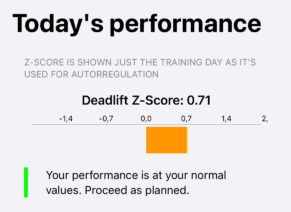In previous publications, we’ve mentioned that the daily condition of the athlete varies depending on a multitude of factors. Your resistance training is one of them. The theory is all very well, but how can we know approximately how much our performance has varied today? There are several ways. Spleeft uses Z-Scores because of their simplicity in visualizing the data.
FATIGUE
Fatigue has a multifactorial nature that makes it very difficult to understand in many cases. It is a component of the coach’s game to give those stimuli that make our athletes improve. Examples of factors are the time of day, the season, previous training, nutrition, sleep, mental state… An infinite number of factors that interact in a complex way, resulting in the sensation of fatigue.
Strength training is often “complementary” in training programs to improve performance. In endurance sports, there is much talk of concurrent endurance training alongside strength. The strength session is likely to follow an endurance loading day or session. It is therefore necessary for the athlete to have the tools to manage their fatigue and adapt their training plan. This will help to give just the right stimulus to the body that it is able to assimilate at that time.
MANAGING FATIGUE IN YOUR RESISTANCE TRAINING WITH Z-SCORES
Z-Scores are descriptive statistics that show how far away a value is from the mean. Measured in n standard deviations. They are calculated by subtracting the value to be compared minus the mean divided by the standard deviation. Positive values are considered better than normal and negative values worse than normal, with normal being individualized to the athlete. Values of +- 1 are normal variations in performance.
HOW DOES SPLEEFT CALCULATE Z-SCORES?

In the case of barbell velocity, Spleeft filters your data according to the date range and the exercise selected in the settings. Also, the loads used on the day on which the training is performed. It obtains a list of the loads used on that day and the highest velocity at which you have lifted on previous days. Based on this data, it calculates the Z-Score of each load and gives as the final Z-Score the average of each load performed that day. You need to work with a certain weight at least three days to be able to calculate your Z-Score.
For example, if you do four workouts with 55 kg and get: 0.65, 0.55, 0.64 and today at 0.67 m/s. To calculate the Z-Score you should subtract 0.67 minus the average of the mentioned velocities and divide it by the standard deviation. This will give you 0.8. This value, being less than 1, would be considered normal, so you could continue with the training without any problems.
Spleeft is available for iOS and Android here.
